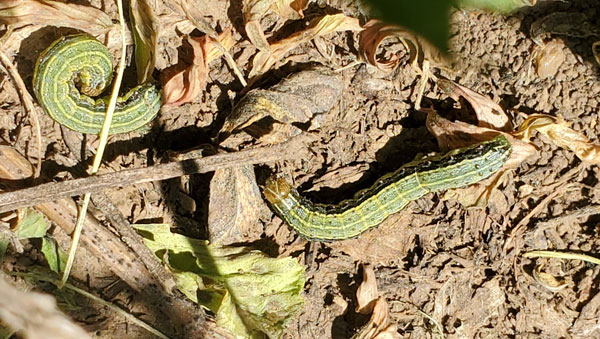We might end up remembering 2021 as the "Year of the Worm". Starting in late winter 2020/early spring 2021, there was considerable activity by army cutworms. Most of the problem was caused by the larvae decimating thin stands of wheat and/or alfalfa. Then, in late spring/early summer, a combination of armyworms and fall armyworms caused serious concern and damage in lawns, pastures, and alfalfa fields throughout about the eastern two-thirds of the state.
Army cutworms spend the summer in the Rocky Mountains but start to migrate back into Kansas in early fall every year. The larvae may feed on just about any plants but mostly affect wheat and alfalfa as these are usually the only plants actively growing this time of year.
Armyworms, probably more so than fall armyworms, may continue to cycle through another generation, or even two, as they overwinter in Kansas. Ultimately it will probably take a hard frost or freeze to stop them. Fall armyworms, since they don't usually overwinter in Kansas, may migrate south after this generation matures into adults, but there could be another, or at least, partial generation.
Armyworms infest primarily grasses (sorghum, corn, brome pastures, lawns, etc.) and often this time of year, wheat, but occasionally alfalfa. Thus, if armyworms are the problem, they could be around through another generation or maybe even two depending upon the weather. If armyworms are relatively small (Figure 1), they will probably feed for another 10-14 days, then pupate (stop feeding). If they are relatively large however (Figure 2), they will probably pupate in the next 3-7 days. There will probably be at least one more generation of armyworms. Fall armyworms (Figure 3) have a little wider host range which includes alfalfa, soybeans, corn, sorghum, and wheat, but don't usually overwinter in Kansas. Hopefully, they will be heading south after these larvae finish feeding and become moths. Also, in the next 30-60 days army cutworm moths should have returned from their summer Rocky Mountain retreat to deposit eggs throughout at least the western two/thirds of the state and thus, these tiny worms will start feeding on wheat and/or alfalfa all winter.

Figure 1: Small armyworm. Photo by Cayden Wyckoff, K-State Research and Extension.

Figure 2: Larger armyworm. Photo by Cayden Wyckoff, K-State Research and Extension.

Figure 3: Fall armyworms. Photo by Jay Wisbey, K-State Research and Extension.
Jeff Whitworth, Extension Entomology Specialist
jwhitwor@ksu.edu
Tags: wheat insects alfalfa army cutworms armyworms fall armyworms